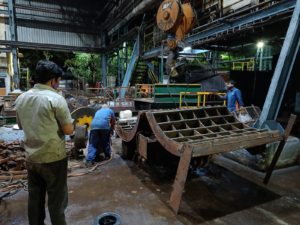Redefining Anvil Reconditioning: Tackling Wear and Tear for Enhanced Efficiency
In the dynamic and demanding world of cane processing, anvil performance is of utmost importance. As one of the key components in the machinery, the anvil bears the brunt of heavy impacts and high-speed abrasion from the cane. Given the acidic nature of sugar juice and the presence of silica, the wear and tear on the anvil are significantly exacerbated, necessitating frequent maintenance and, in some cases, replacement.
Traditionally, the anvil has been designed with deep pockets to help manage these challenges. However, as the industry has evolved, so too have the demands placed on these critical components. High hardness has become an increasingly important requirement for anvils, in order to resist the heavy impact and the abrasive nature of the cane at high speeds.
Understanding Anvil Wear and Its Causes
The wear that anvils experience is not just a result of regular use. It occurs primarily due to three major factors:
Heavy Impact Abrasion: During the cane processing, anvils are subjected to heavy impact from the cane. This, combined with the high operational speeds, leads to substantial abrasion, contributing to the wear and tear on the anvil.
Erosion Due to Silica: The presence of silica in the cane adds to the wear on the anvil. The hard, abrasive nature of silica causes erosion, gradually wearing down the anvil over time.
Corrosion from Acidic Sugar Juice: The sugar juice produced during the cane processing has a naturally acidic nature. This can lead to corrosion of the anvil, further reducing its lifespan and effectiveness.
These factors combined make anvil reconditioning a regular necessity in the industry. However, traditional methods can be time-consuming and costly, and often provide only a temporary solution to the problem.

Towards Improved Anvil Reconditioning
In light of these challenges, there is a pressing need for more effective solutions to anvil reconditioning. Research and development efforts are currently focused on finding materials and designs that can better withstand the impact, abrasion, and corrosion that anvils face. By doing so, the frequency of maintenance can be reduced, and the overall operational efficiency of cane processing machinery can be improved.
Moreover, advances in reconditioning techniques can also help to extend the life of existing anvils. Using state-of-the-art tools and technologies, it’s now possible to repair and refurbish worn anvils, restoring them to near-original condition and performance. Such advances not only save time and money but also help to minimize waste and downtime.
In conclusion, anvil reconditioning represents a significant challenge and opportunity within the cane processing industry. By understanding the causes of anvil wear and developing improved reconditioning techniques, it is possible to greatly enhance the efficiency and profitability of cane processing operations. At IMCO, we are dedicated to exploring and implementing these innovative solutions, ensuring our clients have access to the very best in anvil reconditioning technologies.






